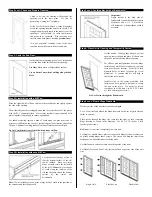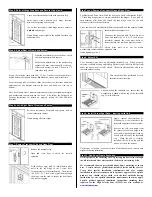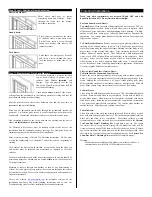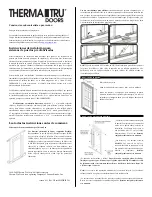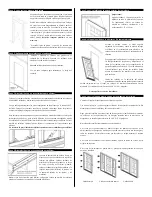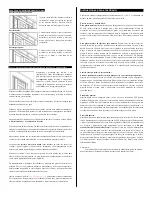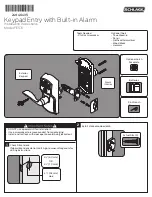
Step 10 cont.: Additional Frame Anchoring.
Doors with Sidelites:
Shim above mull post or jambs
separating doors and sidelites. Screw
through the frame into the header,
adjacent to the shims.
Double doors:
Place
temporary
shims above the center
of the head frame, where doors meet.
Pre-drill and insert a screw through
frame into header, then remove the
temporary shims.
Patio Doors:
Shim above the mull post(s), Pre-drill
and insert a screw through the frame
into the header, at either side of the
post.
Step 11: Weatherproof, Finish and Maintain.
Provide and maintain a properly installed
cap or head flashing to protect top of
surfaces from
Water intrusion
and
damage. Tape and properly seal the top
flap of the Water Resistive Barrier (WRB)
over the head flashing.
Caulk around
entire
“weather” side of unit,
sealing along the brickmould to the flashing material or siding and seal all
joints between the jambs and moldings.
Seal the joints between the exterior hardware trim and the door face to
prevent
air and water infiltration.
Place and set galvanized finish nails through the brickmould around the
perimeter. Use exterior grade screws if you are installing a storm door to the
brickmould. Countersink all fasteners and cover with exterior grade putty.
Add insulation material to the cavity between the opening and the unit to
reduce
air infiltration
and
heat transfer
.
All Therma-Tru Steel doors must be finished within several days of the
installation date for continued warranty coverage. For Fiberglass doors the
finishing requirement is within 6 months of installation.
Paint or stain according to Therma Tru Finishing instructions. Do Not paint
or stain the weatherstrip, it is “friction-fit” and easily removed for painting or
staining.
All 6 sides of the doors must be finished. For out-swing doors the sides, top
and bottom must be inspected and maintained as regularly as all other
surfaces.
All bare wood surfaces such as the door frame exposed to weather should be
primed and painted or stained and top coated
within
two weeks of exposure
for best performance.
Maintain or replace sealants and finishes as soon as any deterioration is
evident. For semi-gloss or glossy paint or clear coats, do this when the surface
becomes dull or rough. More severe climates and exposures will require more
frequent maintenance.
Access our website
www.thermatru.com
for printable versions of the
installation and Same Day Stain finishing instructions and to view our
Troubleshooting video for minor installation issues and adjustments.
Finishing Instructions.
Work only when temperatures are between 50°and 90°F and with
humidity less than 85%. Do not finish in direct sunlight
.
Steel and Smooth-Star® Doors:
To paint Doors:
Clean first with mild detergent and water or use a TSP (tri-
sodium phosphate) solution. Rinse well and allow to dry completely. Mask
off hardware, glass and remove weatherstripping before painting. Use high-
quality acrylic latex house paint, following manufacturer’s directions for
application. Use exterior grade finishes for outside surfaces. Paint edges and
exposed ends of door.
To Paint Doorlite Frames:
Remove any excess glass glazing sealant by first
spraying with a window cleaner or water. Use a single edge razor blade to
score the glazing along the edge of the frame. Holding the razor blade at a 45
degree angle, scrape glazing from glass. Wipe remaining residue off with
window cleaner or mineral spirits. Clean frame with a mild detergent and
water, or use a TSP solution. Rinse well and allow to dry completely. Mask
off glass. Prime door lite frames with an alkyd- or acrylic-based primer.
Allow primer to dry before applying finish paint coats. Use high-quality
acrylic latex house paint, following manufacturer’s application instructions.
Use exterior grade finishes for outside surfaces.
Classic-Craft® and Fiber-Classic® Doors:
To Finish Doorlite Frames and Panel Inserts:
Remove any excess glazing sealant by first spraying with a window cleaner or
water. Use a single edge razor blade to score the glazing along the edge of the
frame. Holding the razor blade at a 45° angle, scrape glazing from glass.
Wipe remaining residue off with window cleaner or mineral spirits. Mask off
glass. Paint or stain using same materials as for the door. (See below).
To Paint Doors:
Clean first with mild detergent and water or use a TSP (tri-sodium phosphate)
solution. Rinse well and allow to dry completely. Prime with an alkyd- or
acrylic-based primer. Allow primer to dry completely, then paint with acrylic
latex house paint, following paint manufacturer’s application instructions.
Use a primer and paint that are compatible. Use exterior grade finishes for
outside surfaces. Paint edges and exposed ends of door.
To Stain Doors:
Clean first with a clean cloth and mineral spirits and allow to air dry or wash
door with mild detergent and water, or a TSP (tri-sodium phosphate) solution.
Rinse well and allow to dry completely. For stained surfaces, we only
recommend the use of the stain and clear coat products found in the
Therma-
Tru Same-Day Stain™ Finishing Kit
. Apply stain with a rag. The longer
the stain is left to “setup” before wiping off, the darker the color will be.
Using a clean rag, wipe off the stain to the color shade you desire. Remove
any excess stain from the panel grooves with the foam brush provided; allow
the stain to dry for at least 6 hours before applying topcoat. See
Therma-Tru
Same-Day Stain™ Finishing Kit
instructions for complete details.
Warning:
Modification or machining of this product can release wood dust, a
substance known to the State of California to cause cancer.


